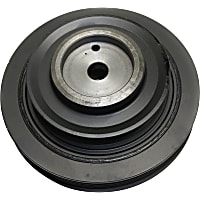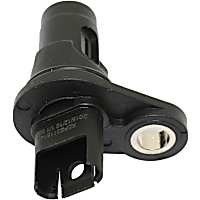One automotive part that frequently gets overlooked is the harmonic balancer (also known as a vibration damper or crankshaft damper). Although the component is often forgotten, when it fails, it can cause major problems—including severe engine damage.
Do you have a sinking feeling that you might have a bad harmonic balancer? If you’re experiencing one or more of the symptoms below, you may be right.
Bad Harmonic Balancer: Signs to Watch Out For
When this component fails, it can cause a range of issues. The most common symptoms of a bad harmonic balancer include:
Engine Vibrations
The harmonic balancer’s job is to dampen vibrations applied to the crankshaft. As a result, when the balancer fails, you may feel a significant vibration from the engine compartment.
Noticeable Harmonic Balancer Wobble
When the rubber isolator begins to deteriorate, the balancer usually begins to separate, creating a noticeable wobble when the engine is running.
Unusual Noises
A faulty balancer can result in a knocking, rattling, or squeaking sound that corresponds with engine speed. In some cases, the noise is bad enough to be mistaken for an internal engine problem.
Also, a balancer that’s beginning to fail can cause abnormal movement from the drive belt or automatic drive belt tensioner, resulting in clicking or squealing noises when the engine is running.
Illuminated Check Engine Light
Your car’s primary computer, which is often referred to as the powertrain control module (PCM), relies on a crankshaft position (CKP) sensor signal to determine crankshaft position and speed.
The CKP sensor reads a toothed or notched wheel that’s usually located on the crankshaft or harmonic balancer. If the harmonic balancer fails, it can cause the sensor to create an abnormal signal, prompting the PCM to turn on the check engine light.
Visible Wear or Damage
If you take a look at the harmonic balancer, you might be able to see visible wear or damage. For example, the rubber insulator may have deteriorated, resulting in a separation between the hub and outer portion of the balancer.

What is a Harmonic Balancer?
So what does a harmonic balancer do? The primary purpose of the balancer is to absorb vibrations applied to the engine’s crankshaft.
With a four-stroke engine, each piston completes four separate strokes—intake, compression, power, and exhaust—while turning the crankshaft. When a piston moves downward during the power stroke, it causes the crankshaft to speed up.
At the same time, another piston is moving upward during the compression stroke, forcing the crankshaft to slow down. As a result, opposing forces are applied to the crankshaft, creating a dangerous resonance phenomenon.
The harmonic balancer moderates the high-frequency vibrations acting on the crankshaft. A typical balancer has a center hub, an inertia ring, and a rubber insulator (some designs use viscous fluid rather than rubber). The center hub is bolted to the end of the crankshaft. As the crankshaft twists and turns, the inertia ring and rubber ring absorb some of the resulting vibrations.
Also, the harmonic balancer has a pulley (either integral or bolted on) that connects to the engine’s drive belt. When the engine is running, the pulley turns the belt, which, in turn, causes the engine-driven accessories (alternator, A/C compressor, etc.) to rotate.
What Happens When a Harmonic Balancer Fails
Although the harmonic balancer may seem simple enough, if it fails, it can cause major problems. Without the balancer dampening unwanted crankshaft vibrations, engine failures, such as worn rod bearings and a broken crankshaft, may result.
A faulty balancer can damage the belt and engine-driven accessories as well. It’s also possible for the balancer to fly apart, resulting in the destruction of a variety of underhood components.
Without a doubt, you should always replace a faulty harmonic balancer right away.
Products Mentioned in this Guide
Any information provided on this Website is for informational purposes only and is not intended to replace consultation with a professional mechanic. The accuracy and timeliness of the information may change from the time of publication.


 Harmonic Balancer
Harmonic Balancer
 Crankshaft Position Sensor
Crankshaft Position Sensor



























76 302 idles smooth. Vibrates when you rev it up. Put it in gear and pushed in the clutch and still does it. I was told it could be either the clutch or the balancer. Any advice that won’t make my wife make me choose her or the truck
In regards to harmonic balancer I have a 91 Honda Accord and have had following symptoms: car vibration, noise like metal, battery light is on, belt is not spinning and BF said pulley is not spinning after taking a look. Any theories on what it is or where to start? Desperate for help and not a lot of money to fix, thank you.
Hello,
If the alternator belt isn’t turning (but it’s still intact), it sounds like either the alternator or the A/C compressor is seized. The problem should be fairly easy to pinpoint by looking at the belt area at the front of the engine.
I have a 2011 Hyundai accent and it started running real bad just doesn’t want to accelerate I got it read and the code it showed pointed to the camshaft sensor crankshaft sensor and engine timing I got both sensor and put them on and still running the same I got the timing belt and got that changed and still the same problem poor acceleration rough idling sometimes it even dies but my harmonic/crankshaft pulley is wobbling so bad it looks like it’s gonna fly off and it’s tight. I order a new one and just waiting on it to come in could this be the problem? And I also read where sometimes you have to have your camshaft and crankshaft sensor relearned after you replace them is this something I might have to look at doing too?
Hello,
What is the number of the code that keeps returning?
As far as the balancer goes, if it’s wobbling all over like that, you’re right that it needs to be replaced.
Can a bad harmonic balancer / broken key way cause the engine to stop running ? Due to the timing being off ?
If you’re harmonic balancer is broken will that stop your car from starting